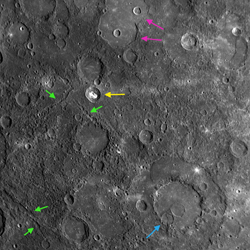
Click on the image
for larger versionThis NAC image displays a number of interesting geologic features characteristic of Mercury’s surface. The crater indicated by the yellow arrow has unusual bright material on its floor, likely due to rocks of a different chemical composition. Bright material also has been seen in the craters Sander and Kertész. The pink arrows point to a pair of larger and older craters that have been flooded with now solidified volcanic lava, similar to flooding seen at the impact basin Raphael. In the lower right-hand corner of the image is a large peak-ring basin, about 210 kilometers (130 miles) in diameter, which also appears to have been flooded with lava. There is a small scarp (cliff) within that basin that cuts through a smaller crater at the edge of the basin's inner ring, at the point indicated by the blue arrow. Scarps on Mercury are often seen intersecting impact craters, such as this dramatic, previously released image from the mission's second Mercury flyby (see PIA11358). The green arrows on the left side of the image indicate a series of secondary crater chains. Chains of small craters such as these are formed when ejecta are expelled from a primary crater after the initial impact. Secondaries are widespread across Mercury's surface, as was also discussed in the caption to this previously released image (see PIA10178). Unraveling Mercury's geologic history requires investigating the complex and overlapping relationships of volcanic plains, impacts, and scarps seen on the planet's surface.
Date Acquired: October 6, 2008
Image Mission Elapsed Time (MET): 131774026
Instrument: Narrow Angle Camera (NAC) of the Mercury Dual Imaging System (MDIS)
Resolution: 540 meters/pixel (0.33 miles/pixel)
Scale: This image is about 550 kilometers (340 miles) across
Spacecraft Altitude: 21,000 kilometers (13,000 miles)
These images are from MESSENGER, a NASA Discovery mission to conduct the first orbital study of the innermost planet, Mercury. For information regarding the use of images, see the MESSENGER image use policy.

